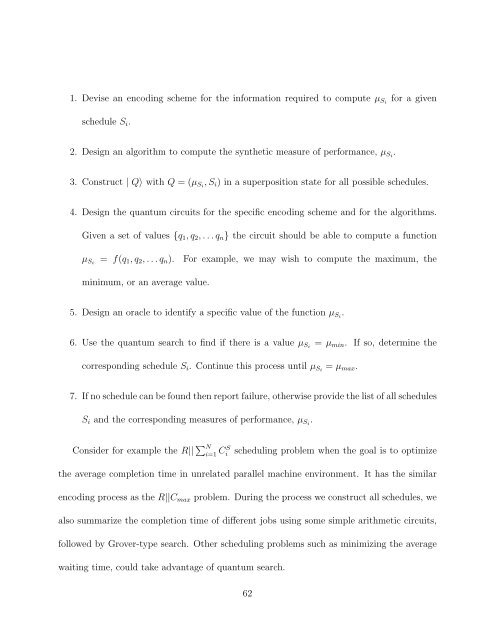t b a b a
t b a b a
t b a b a
Create successful ePaper yourself
Turn your PDF publications into a flip-book with our unique Google optimized e-Paper software.
1. Devise an encoding scheme for the information required to compute µSi for a given<br />
schedule Si.<br />
2. Design an algorithm to compute the synthetic measure of performance, µSi .<br />
3. Construct | Q〉 with Q = (µSi , Si) in a superposition state for all possible schedules.<br />
4. Design the quantum circuits for the specific encoding scheme and for the algorithms.<br />
Given a set of values {q1, q2, . . . qn} the circuit should be able to compute a function<br />
µSi = f(q1, q2, . . . qn). For example, we may wish to compute the maximum, the<br />
minimum, or an average value.<br />
5. Design an oracle to identify a specific value of the function µSi .<br />
6. Use the quantum search to find if there is a value µSi = µmin. If so, determine the<br />
corresponding schedule Si. Continue this process until µSi = µmax.<br />
7. If no schedule can be found then report failure, otherwise provide the list of all schedules<br />
Si and the corresponding measures of performance, µSi .<br />
Consider for example the R|| � N<br />
i=1 CS i scheduling problem when the goal is to optimize<br />
the average completion time in unrelated parallel machine environment. It has the similar<br />
encoding process as the R||Cmax problem. During the process we construct all schedules, we<br />
also summarize the completion time of different jobs using some simple arithmetic circuits,<br />
followed by Grover-type search. Other scheduling problems such as minimizing the average<br />
waiting time, could take advantage of quantum search.<br />
62

















